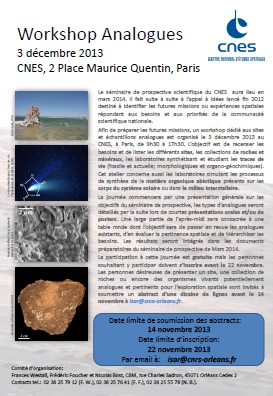Lastest News
Important update of ISAR databaseParticipation to IPPW 2017Participation to AbSciCon 2017 See allMy selection
Contact us
ISAR,
Frances Westall,
Frédéric Foucher,
Centre de Biophysique Moléculaire,
UPR CNRS 4301,
rue Charles Sadron,
45071 Orléans Cedex 2
France
Mentions légales
Participation to EPSC 2014 in Cascais 2014-09-08
The ISAR was presented during the EPSC 2014 in the Centro de Congressos do Estoril, Cascais, Portugal, September 07-12, 2014:
A Blind Test to assess the future ExoMars instruments using samples from the ISAR collection
F. Foucher, F. Westall, and N. Bost
(abstract 472-1).
Workshop Analogue report2014-01-21
A workshop dedicated to analogue sites, samples and organisms, and to simulations of extraterrestrial synthesis of organic molecules, was organized on December the 3rd of 2013 in the CNES, in Paris.
The report of this very fruitful event is available via this link:
REPORT
N.B.: Report in French.
Workshop Analogue2013-10-22
A workshop dedicated to analogue sites, samples and organisms will be held on December the 3rd of 2013 in the CNES, in Paris. This event will be also devoted to simulations of extraterrestrial synthesis of organic molecules. (Details)
The ISAR will be presented during this event.
N.B.: This workshop will be held in french.
Participation to EPSC 2013 in London 2013-09-13
The ISAR was presented during the EPSC 2013 in the University College London, London, United Kingdom, September 08-11, 2013:
The International Space Analogue Rockstore (ISAR) for in situ instrument testing: relevance for Martian missions.
F. Westall, N. Bost, F. Foucher, C. Ramboz, and L. Loiselle
(abstract 207).
Publication in Planetary and Space Science2013-06-20
Missions to Mars: Characterisation of Mars analogue rocks for the International Space Analogue Rockstore (ISAR)
N. Bost, F. Westall, C. Ramboz, F. Foucher, D. Pullan, A. Meunier, S. Petit, I. Fleischer, G. Klingelhöfer and J. Vago
Abstract:
Instruments for surface missions to extraterrestrial bodies should be cross-calibrated using a common suite of relevant materials. Such work is necessary to improve instrument performance and aids in the interpretation of in-situ measurements. At the CNRS campus in Orléans, the Observatoire des Sciences de l'Univers en région Centre (OSUC) has created a collection of well-characterised rocks and minerals for testing and calibrating instruments to be flown in space missions. The characteristics of the analogue materials are documented in an accompanying online database. In view of the recent and upcoming rover missions to Mars (NASA's 2011 Mars Science Laboratory (MSL) and ESA/Roscosmos' 2018 ExoMars), we are concentrating initially on materials of direct relevance to the red planet. The initial collection consists of 15 well-studied rock and mineral samples, including a variety of basalts (ultramafic, weathered, silicified, primitive), sediments (volcanic sands, chert, and a banded iron formation –BIF-), and the phyllosilicate nontronite (a clay). All the samples were characterised petrographically, petrologically, and geochemically using the types of analyses likely to be performed during in-situ missions, in particular ExoMars: hand specimen description; optical microscopy; mineralogical analysis by XRD, Raman and IR spectrometry; iron phase analysis by Mössbauer spectroscopy (MBS), elemental analysis by Energy-Dispersive X-ray spectroscopy (EDX), microprobe, Inductively Coupled Plasma Atomic Emission Spectrometry (ICP-AES) and Mass Spectrometry (ICP-MS); and reduced carbon analysis by Raman spectrometry.
Planetary and Space Science, 82-83, 113–127, 2013 (abstract).













